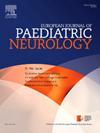Duchenne and Becker Muscular Dystrophies in Romania: a 10-year Retrospective Study
IF 2.3
3区 医学
Q3 CLINICAL NEUROLOGY
引用次数: 0
Abstract
Duchenne muscular dystrophy (DMD) is a rare fatal genetic disorder with a tight correlation between the genotype and the phenotype of the patients. However, the relationship between genotype and phenotype is yet incompletely understood, with some cases manifesting a different phenotype than predicted from their genotype. Since the genetic diagnosis is often targeted to specific gene sections, and the genotype-phenotype correlations guide early treatment decisions, accumulating clinical and epidemiological data for these rare disorders is required to refine local management strategies. This article describes the genotype and phenotype landscape of 239 patients treated in the Pediatric Neurology Clinic of the Clinic Psychiatry Hospital ”Prof. Dr. Alexandru Obregia” in Bucharest, using randomly collected data from a ten-year interval (2012–2022). It revealed a significant improvement in the quality of care, highlighted by a notable reduction in the average age at diagnosis in recent years, although considerable variability remains across counties. The study identified three mutations that were not previously described in the Edystrophin or TREAT-NMD DMD Global Database. The accuracy of the Reading-Frame rule was 88.4 % for deletions. For exceptions from the rule, the involvement of different isoforms, binding domains, structural domains, and the disturbance of the three-dimensional structure of the rod domain were not reliable indicators of the phenotype. 12.9 % of all patients had nonsense mutations with a DMD phenotype that could benefit from Ataluren treatment within the National Treatment Program, and 15 % were eligible for exon-skipping therapies, with exon 51 having the broadest applicability (7.1 %).
罗马尼亚的Duchenne和Becker肌营养不良症:一项10年回顾性研究
杜氏肌营养不良症(DMD)是一种罕见的致死性遗传性疾病,其基因型与患者的表型密切相关。然而,基因型和表型之间的关系尚不完全清楚,一些病例表现出与基因型预测不同的表型。由于遗传诊断通常针对特定的基因部分,并且基因型-表型相关性指导早期治疗决策,因此需要积累这些罕见疾病的临床和流行病学数据来完善局部管理策略。这篇文章描述了在临床精神病院儿科神经病学诊所治疗的239名患者的基因型和表型景观。Alexandru Obregia博士在布加勒斯特的研究,使用了十年间隔(2012-2022)随机收集的数据。它揭示了护理质量的显着改善,突出显示了近年来诊断时平均年龄的显着降低,尽管各县之间仍然存在相当大的差异。该研究确定了三种以前在Edystrophin或TREAT-NMD DMD全球数据库中未描述的突变。对于删除,读框规则的准确率为88.4%。对于规则的例外,不同的同工异构体、结合域、结构域的参与以及杆状结构域的三维结构的干扰都不是表型的可靠指标。12.9%的患者具有无义突变的DMD表型,可以从国家治疗计划中的Ataluren治疗中受益,15%的患者符合外显子跳跃治疗的条件,其中外显子51具有最广泛的适用性(7.1%)。
本文章由计算机程序翻译,如有差异,请以英文原文为准。
求助全文
约1分钟内获得全文
求助全文
来源期刊
CiteScore
6.30
自引率
3.20%
发文量
115
审稿时长
81 days
期刊介绍:
The European Journal of Paediatric Neurology is the Official Journal of the European Paediatric Neurology Society, successor to the long-established European Federation of Child Neurology Societies.
Under the guidance of a prestigious International editorial board, this multi-disciplinary journal publishes exciting clinical and experimental research in this rapidly expanding field. High quality papers written by leading experts encompass all the major diseases including epilepsy, movement disorders, neuromuscular disorders, neurodegenerative disorders and intellectual disability.
Other exciting highlights include articles on brain imaging and neonatal neurology, and the publication of regularly updated tables relating to the main groups of disorders.

 求助内容:
求助内容: 应助结果提醒方式:
应助结果提醒方式:


